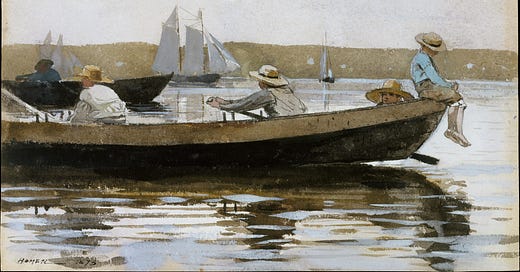A little while ago, I burnt myself out on introspection.
What started out as a reasonable quest for self-awareness curdled into a cycle of over-analysis and hyper-focus on the endless stream of thoughts and emotions. Like a modern-day Narcissus, entranced by the reflective pool of my own interiority and unable to detach myself from it. Now I see the irony: I was trying to become my best self through introspection but got stuck in a labyrinth of ifs and buts, a maze with no discernible exit, only endless corridors leading back into themselves. But back then, I just kept digging deeper. Introspection is meant to reveal who you are. But, instead, it built up walls.
Obviously, making any sort of decision in this state is exhausting. I found myself beset with doubts and wishing I could just turn my brain off. Uncertainty is a way of life and you don’t get anywhere by agonising over every decision and rooting around for meaning. But I did — and I got stuck in a vortex of decision paralysis when I had to make leaps in relationships and work. It was a necessary revelation that introspection isn’t to find the objective right answer. It’s to find out what you want.
Why was that distinction important? For a long time, I would ruminate over decisions, turning every one of them over in my head until the pros and cons were much too muddled. It was an agonisingly slow process and, even then, I didn’t always get it right. That usually had nothing to do with how deep I dug but everything to do with how inflexibly I would expect a certain outcome. Of course, that isn’t the way the world works, and sometimes you have to make raw decisions with very little data to go off of. But when you’re expecting the answer to reveal itself to you right at the start, you’re leaving no room to recalibrate if things go awry, as things are wont to do. The doors swing open to analysis paralysis and introspective burnout.
The only way to break out of this paralysis is really to act. To move a step at a time towards what I’m drawn to until a clear reason emerges to stop. This single step, the minimum viable action, is powerful, because the minute you take it, you set off reactions that arm you with more information. The fog clears a little, and then some more. The abstract concepts and hypothetical outcomes that once dominated your thought process are replaced by real-world feedback. This shift from speculation to evidence is grounding.
But there’s two parts to what I said about moving a step at a time. One, that it’s towards what I’m drawn to. At that point in time, with the information that I have, what feels right to me? That’s really the only clue I need to choose my next direction. It might be what others are telling me to do. It might not be. But this rightness is instinctual, a gut feeling that is resonant enough if I quiet my mind and pay keen attention.
But how does one discern this rightness that serves as a touchstone? Our thoughts and actions are defined by prior conditions, and the sense of rightness is often buried under layers of fear, expectation and conventional wisdom drilled into us from a young age. To sense the signal amidst the noise is a deeply personal practice that calls, above all, for patience with oneself. Meditation helps some; for yet others, it’s writing or taking long, meandering walks. Whatever the method, the end to strive for is the same: a state of flow that momentarily quiets the mind and bypasses the rational brain to tap directly into the intuitive self.
There’s also a certain degree of peripheral awareness necessary to hear warning bells and know when to stop. It won’t do to barrel on heedless of external signs of fire, only because the compass continue to stubbornly point north. Not all decisions lead to permanent outcomes and it's okay to switch tracks (or even backtrack) in light of new information. As Kierkegaard said:
To dare is to lose one's footing momentarily. Not to dare is to lose oneself.
Since we’re taking smaller steps at a time, each decision is dynamic and flexible. It’s easier to turn a line into a circle when you’re putting down single dots instead of a straight line.
For someone frequently ensnared by their own thoughts, this philosophy shift was liberating. It helped me re-channel introspection into a tool for active engagement with the world and a way to carve out a life that is as reflective as it is lived. When you think like this, every decision becomes a conscious act, each step a deliberate placement in a broader design.
The consistency here isn’t necessarily in ways of thinking (and that’s good, because its healthy to recalibrate your opinions based on new information). It’s in the little dots you put down on paper when trying to draw a square or a circle or a rose. The minimum viable actions towards an outcome that makes sense to you until there’s a good enough reason to redirect or stop.





Thank you so much for this writing this Sindhu. Read it this morning while feeling incredibly overwhelmed during my morning commute and it helped streamline my mental wanderings. I did have one query about the concept of minimum viable action though. I always find that actions help gain clarity and momentum, but if it doesn't work for the intended purpose I always resort to the stance that the action just needs to be louder/stronger/harder. How does one go about understanding what the actual minimum viable action is for a particular process is ?